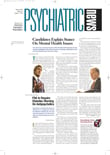Julie (not her real name, but the scenario is real) came to see me for help with depression. She was single, in her mid-20s, still living at home with her parents, and a well-liked, much-respected administrative assistant at a local business. In our initial interview, she described classic neurovegetative symptoms of depression but denied suicidal ideation or intent.
I saw her weekly, felt I had developed good rapport with her, and started her on imipramine, building up to 150 mg a day. I gave her a two-week supply at a time. (This occurred a good decade before the first SSRI was on the market.) By the sixth week, her mood was markedly improved. Sometime during the eighth week of contact with me, she drove out to an isolated path in the woods and, when discovered a day later, was found dead in her car with the recently refilled but now empty container of imipramine next to her. The coroner ruled Julie’s death “suicide, secondary to an arrhythmia from an imipramine overdose.”
I felt enormous guilt for what I felt were errors in judgment—not asking often enough about possible suicidal feelings once she trusted me more and for giving her a two-week supply of a potentially lethal amount of medication. I met with her family several times, was honest about my errors, and dealt with their anger as best as I could.
Julie’s parents ended up not suing me. However, I remember feeling even then—25 years ago—that I owed myself, and certainly Julie and her parents and all of my patients, more than self-blame and guilt. I owed all of us a way of practicing psychiatry in the safest possible way, realizing that the practice of medicine/psychiatry, like most human endeavors, involves risks for patients and for caregivers. However, our task, as clinicians, is to reduce the number of errors to an absolute minimum.
Much has happened to patient safety in the intervening 25 years. We realize that our mindset about patient safety needs to change from one of blame, guilt, or both to creating safe systems of care, or, to put it in the language of patient safety, processes of care that incorporate best practices and reflect systems of independent redundancies. Put simply, what that says is that if I make a mistake, someone (or something/a device, etc.) looking at the care process independently will catch my mistake and correct it.
Some of this may apply more easily to those of you who practice in hospital settings. Other clinicians are more easily available to “double-check” care processes—residents, attendings, nurses, social workers, and pharmacists, as well as technologic aides (various order/entry systems, etc.).
The office practice of psychiatry, where there are often only two people involved—the psychiatrist and the patient—presents particular challenges to practicing safe care. Here are some, but by no means an exhaustive list of, approaches. We know from research that a potentially suicidal patient may not tell us up front about his or her suicidal feelings. We know suicide risk increases (1) whenever a dramatic change in mood occurs and (2) whenever the patient’s treatment status changes (inpatient to partial hospitalization, inpatient to outpatient, etc.). Therefore, we need to make it a point, especially with any relatively new patient, to assess the patient’s suicide status often and especially at any high-risk times.
Most of us who treat outpatients (and, of course, inpatients) deal with the prescribing and managing of psychiatric medications daily. This is especially true in the managed care era of “med-check” office visits. Keeping in mind the principle of safety from redundant systems, we should actively involve (whenever possible) the patient in the medication process. For instance, I have gotten into the habit of having the patient read back to me the prescription(s) I have just handed to him or her. I quickly learned a lot about improving my safe practices—writing more legibly, being clearer about the specifics of my instructions. Likewise, we need to discuss more clearly with the patient the possible interactions of not just what we prescribe, but also interactions with the other medications the patient may be taking. None of us has an excuse not to take out our PDR, but best practice in 2003 almost dictates our routine use of PDAs (and programs such as e-Pocrates or whatever your favorite is) to help us discuss possible medication interactions with our patients.
In the year ahead, the APA Patient Safety Committee has planned a series of educational activities, at the national and district branch levels, to increase patient-safety consciousness in our daily clinical activities. In addition, Psychiatric News will publish a series of articles on patient safety.
Some of you will say, “What is the big deal; this is all common sense!” While that may be partially true, I have been struck by how often (myself included) common sense is practiced uncommonly. Please join us in truly making patient safety an everyday practice. ▪

